Greetings!
Welcome to Scifi-Meshes.com! Click one of these buttons to join in on the fun.
Quick Links
3DFranz Joseph Starfleet
 evil_genius_1804256
Posts: 11,034Member
evil_genius_1804256
Posts: 11,034Member
Image for the thread thumbnail:
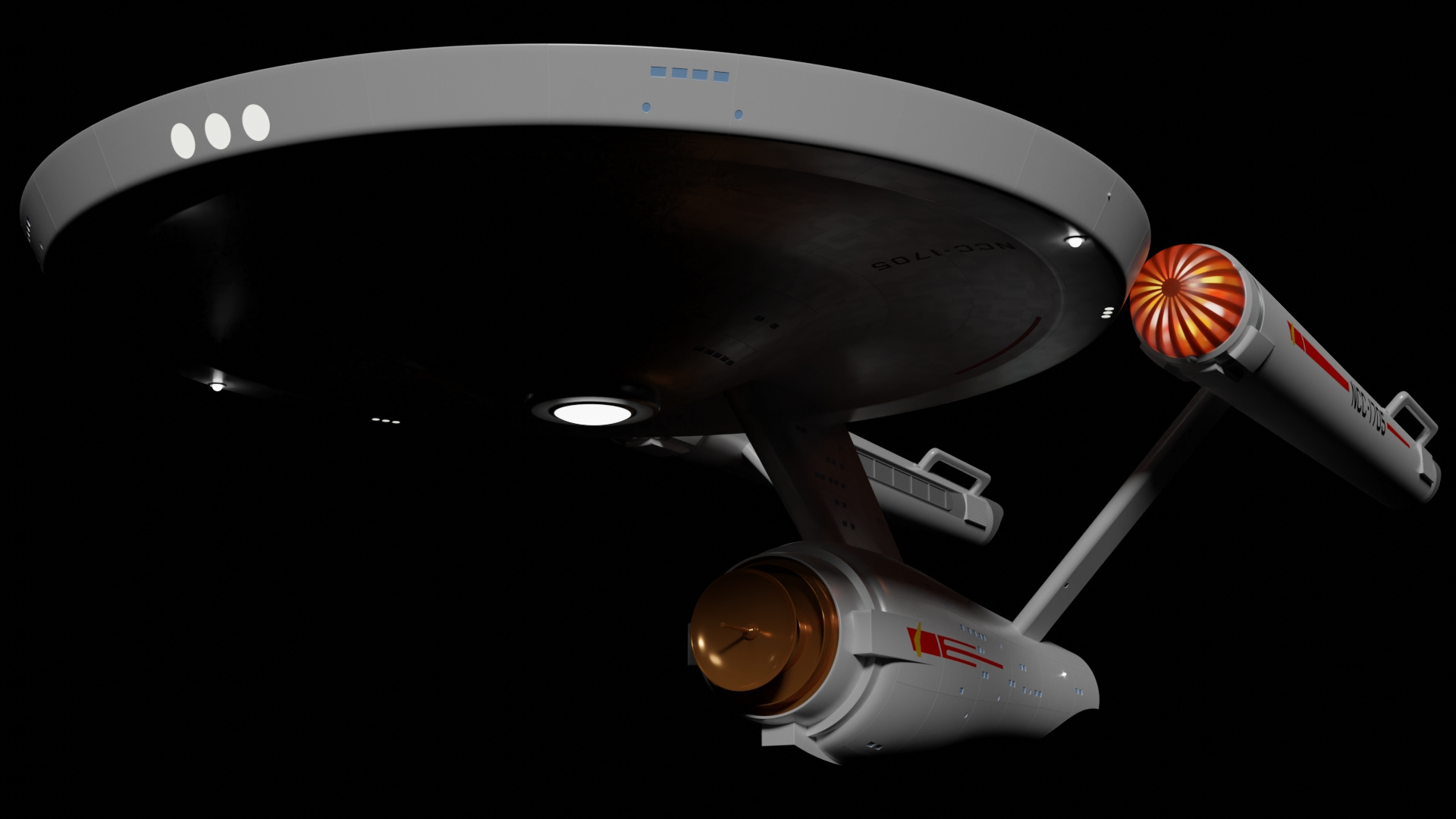
The original post is below:
I'm creating a thread for this to separate it from the other Star Trek projects I do, because this is a project I feel should stand alone. For those who don't know, I've built a lot of TOS Constitution class ships over the years. I don't know how many, I've done them in Truespace and Lightwave. But, I'm using Blender now and I need a Constitution class. But, I don't want to try to recreate the filming models. Not because it's difficult, at this point I can say with no real ego that I can get pretty close to accurate with little effort. That's mainly due to the amount of references available. There are great blueprint sets and lots of photos. So, doing the ship as it appeared on the show is a good thing, but just kind of mundane. Boring, if you will.
But, back before there were great references, before the internet age, there was basically only a couple references for this ship as far as schematics go. Those were the blueprints and technical manual drawn and written by a man named Franz Joseph.
For those who don't know, Franz Joseph was a German technical artist. In WW2, he devised a way to create pretty accurate schematics of enemy planes based on photos. If the photos had a size reference in them, he could even calculate the size. Franz wasn't a Star Trek fan. But, his daughter Karen was. In the early 1970s, she was a member of a local Star Trek fan club. Eventually, the fan club got big enough that they started having meetings. Franz went with her for the first meeting and saw where people in the club had made reproductions of props from the show that were very crude. He told them they could do better, so they said "show us." At home, Karen grabbed some slides from the show and Franz went to work creating schematics of props from the show, starting with the communicator. A week later, he had a few schematics drawn and they invited some members of the fan club over and they went crazy over the schematics. Then they started giving him requests for stuff to draw. He quickly realized they wanted a technical manual, so he set about making one. Using slides, pictures, the show in syndication and any other references he could get, Franz made schematic drawings from Star Trek, the first work of its kind being done by someone not connected to the show. He sent some work to Gene Roddenberry, and Gene loved it and encouraged him to continue. The Star Fleet Technical manual was published in 1975, as were a complete set of Constitution class blueprints that Franz had drawn.
For the longest time, these were the best references we had. To remind people, the actual ship was in the basement of the Smithsonian and had some inaccurate parts on it. So, he couldn't even look at the actual model. He had to get by with the series, photos and slides. Over the years, people have criticized his work as being inaccurate, but I dare any of them to do better with what he had available. I'm sure they couldn't. The more accurate sets of blueprints were done by people with access to the 11' model who could take measurements from it.
Franz's work was even used in the films. In TMP, during the establishing shot of Epsilon IX, you can hear the USS Columbia being ordered to rendevous with the USS Revere. They're both identified a "scout" ships. Both "scout" and those two ship names are straight out of the tech manual. Also, the Dreadnought Entente was calling the station. Both "dreadnought" and the ship name were from the manual. For TWOK, they actually did a series of animated displays for the bridge of the ships and they used pages from the tech manual, so the scout, transport and an outline of the dreadnought all appear on screen and are technically canon. And finally, in TSFS, when Checkov says there's an energy reading from inside Spock's quarters, there are blueprints of the inside of the ship displayed, they're from Franz's blueprint sheets. More recently, a ship obviously based on the scout/destroyer design from the tech manual appeared in Strange New Worlds.
So, I decided to build the Constitution class, but based on Franz Joseph's work. I have both his technical manual and blueprints and I love them, even if they are inaccurate. I started this a few days ago and this is where I am:
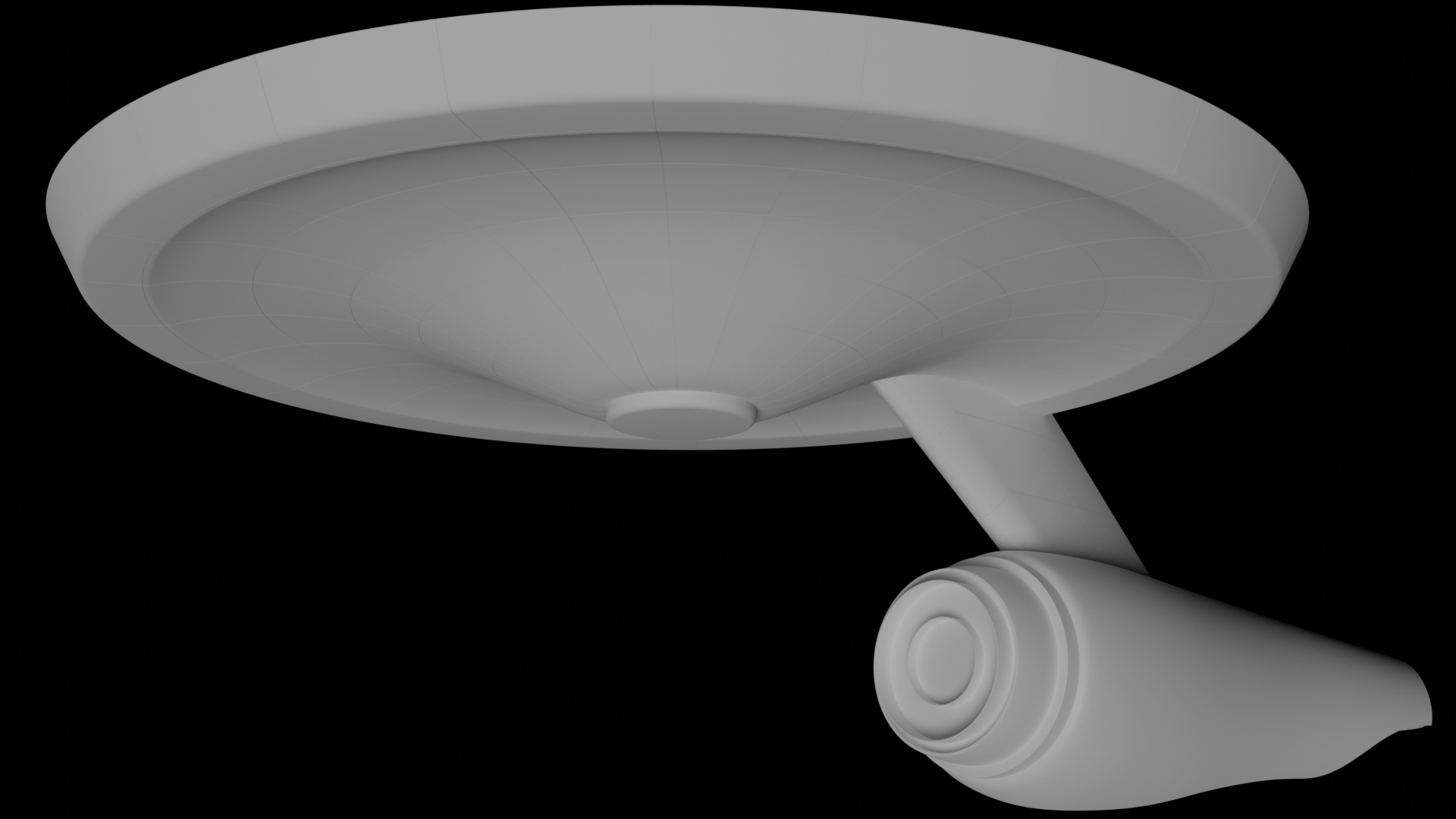

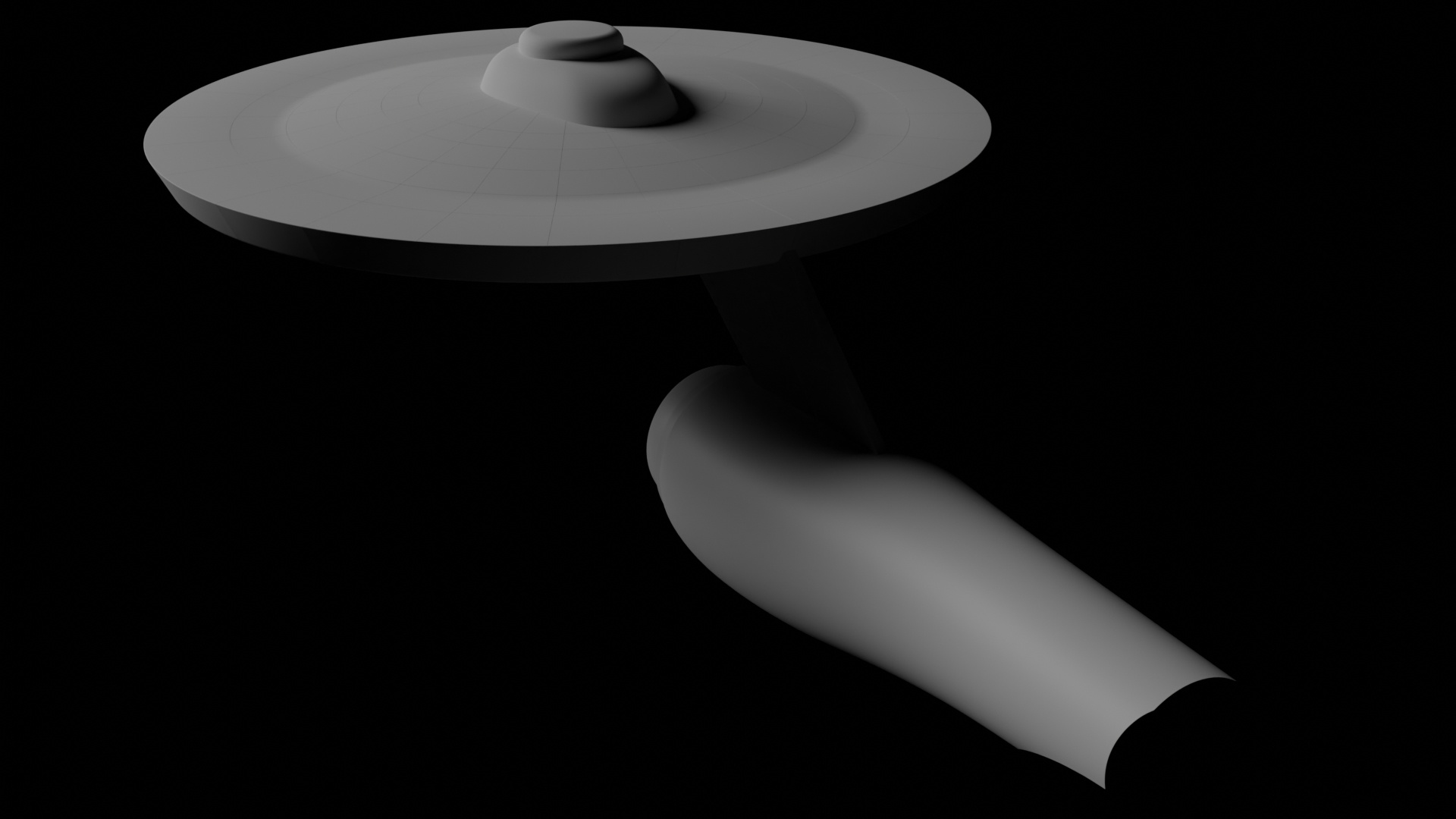

And, some screenshots:
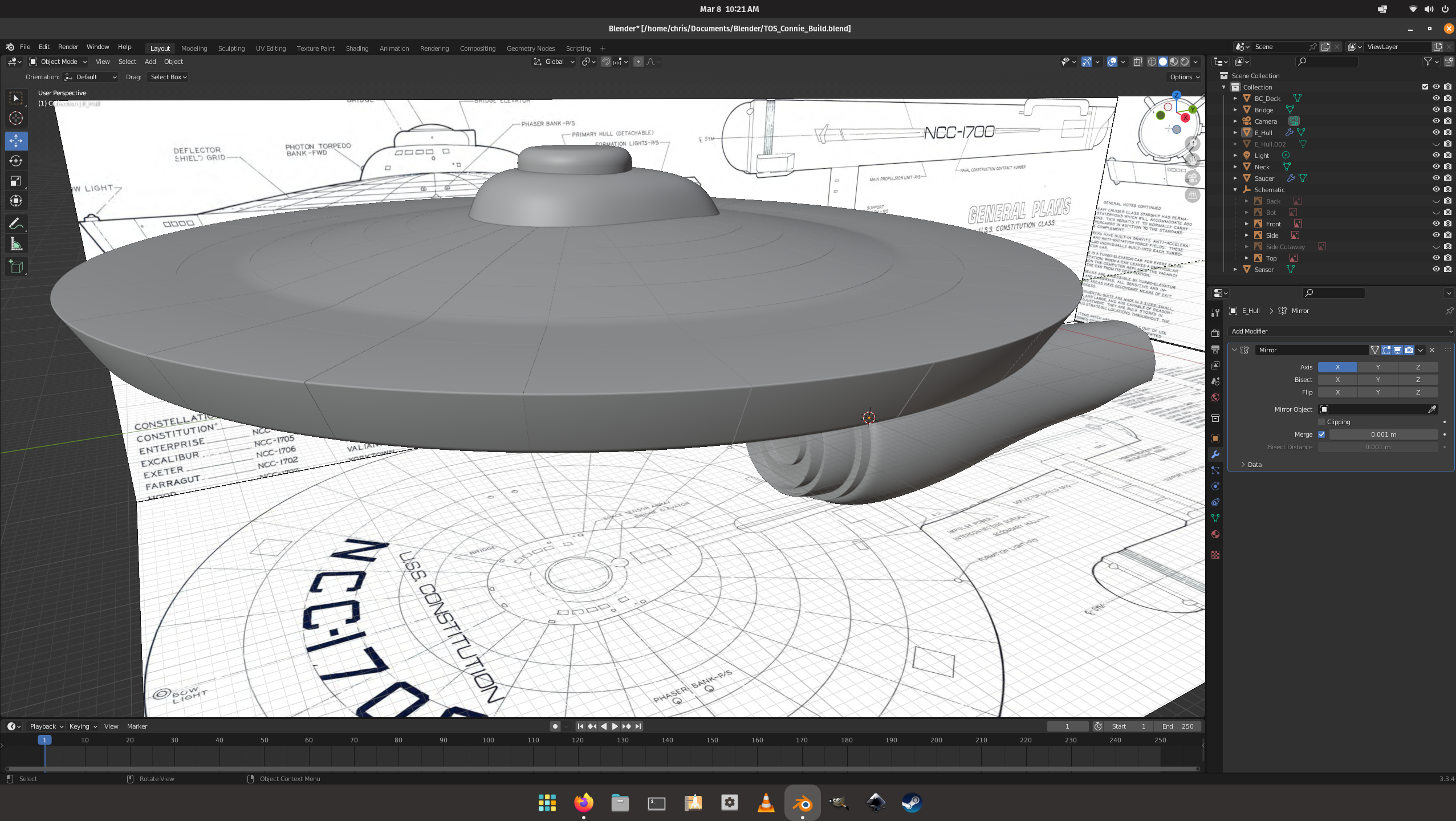

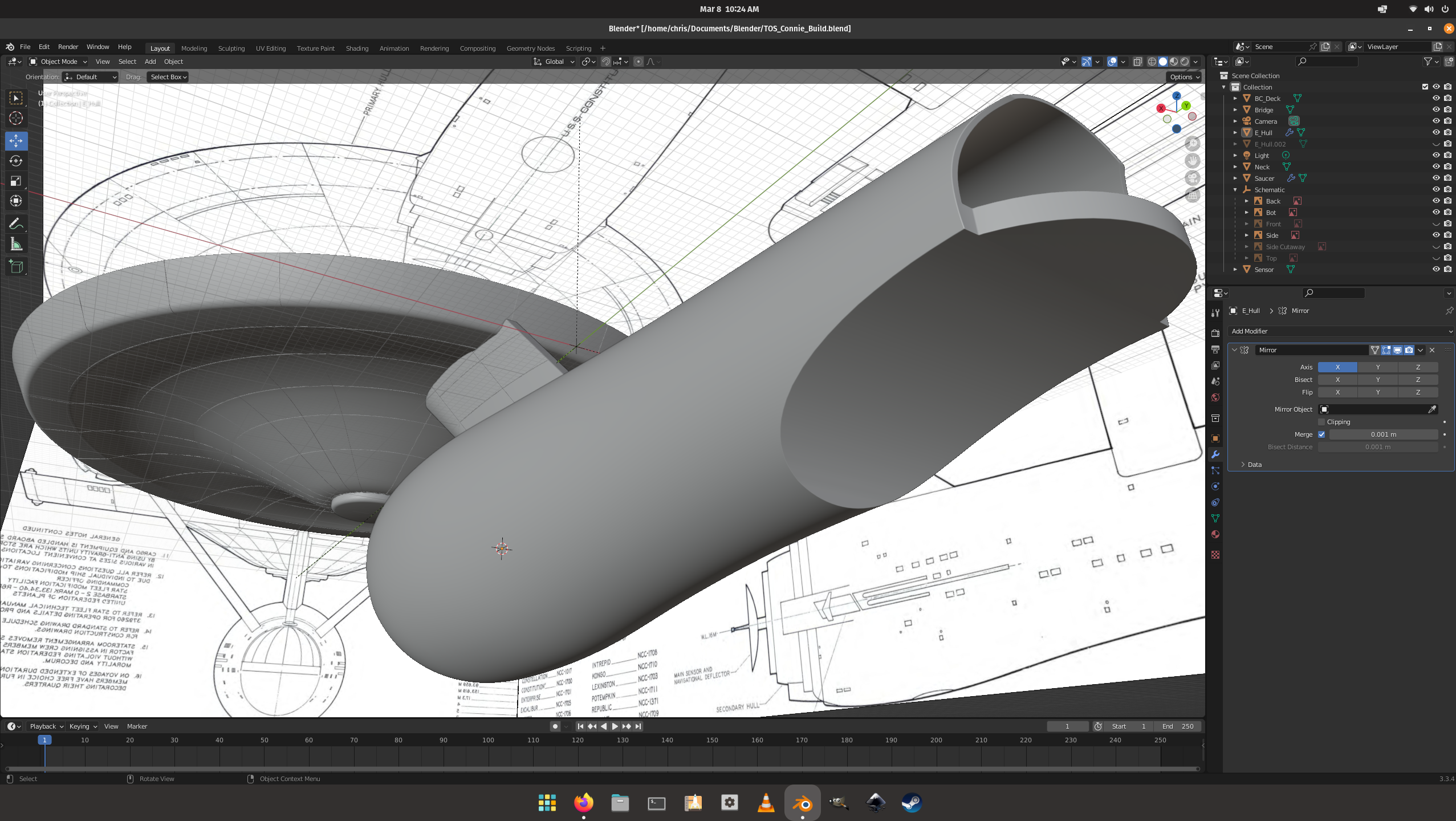
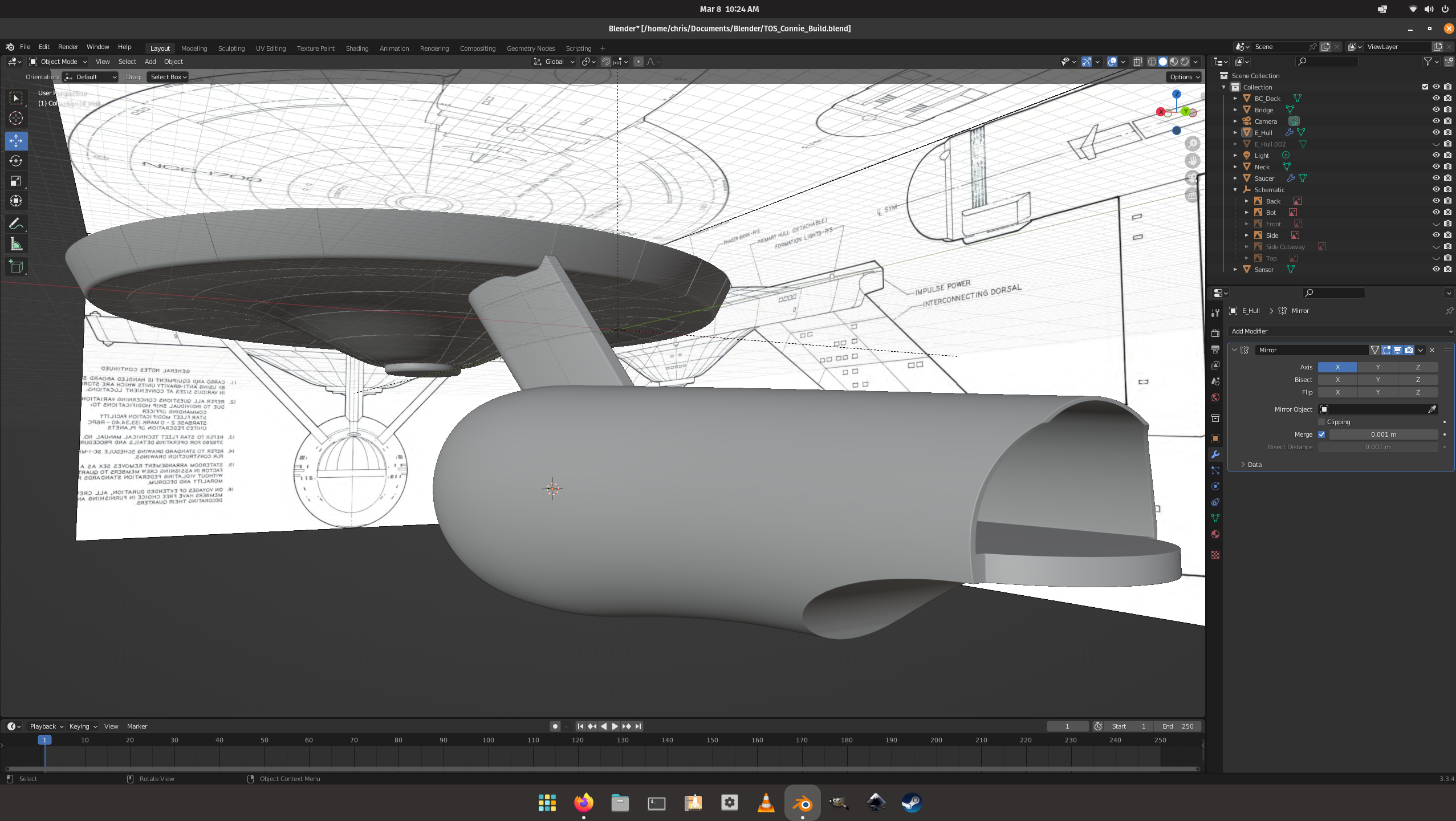

This has been a fun one so far. The secondary hull on the filming models was done on a lathe. However, this version seems to be more based on Matt Jefferies' drawings. The sides and bottom are more bulgy than the top, especially the bottom. So, needless to say, there was some Sub D involved.
As for the rest of the thread, after I do the Connie, I plan to do the other ships from the technical manual, as well as the Starfleet Command space station. I'm only going to use the blueprints available that are based on Franz's work, and the technical manual as my references. I'm not using any other blueprints, photos or screenshots. If anyone says anything is inaccurate based on the filming model, I'm simply going to refer them back to the post. Also, accuracy is in the eye of the beholder. I can say that a ship that looks more like Franz's work appeared at least once in TOS, and that was the USS Constellation, which was built using an AMT model kit:
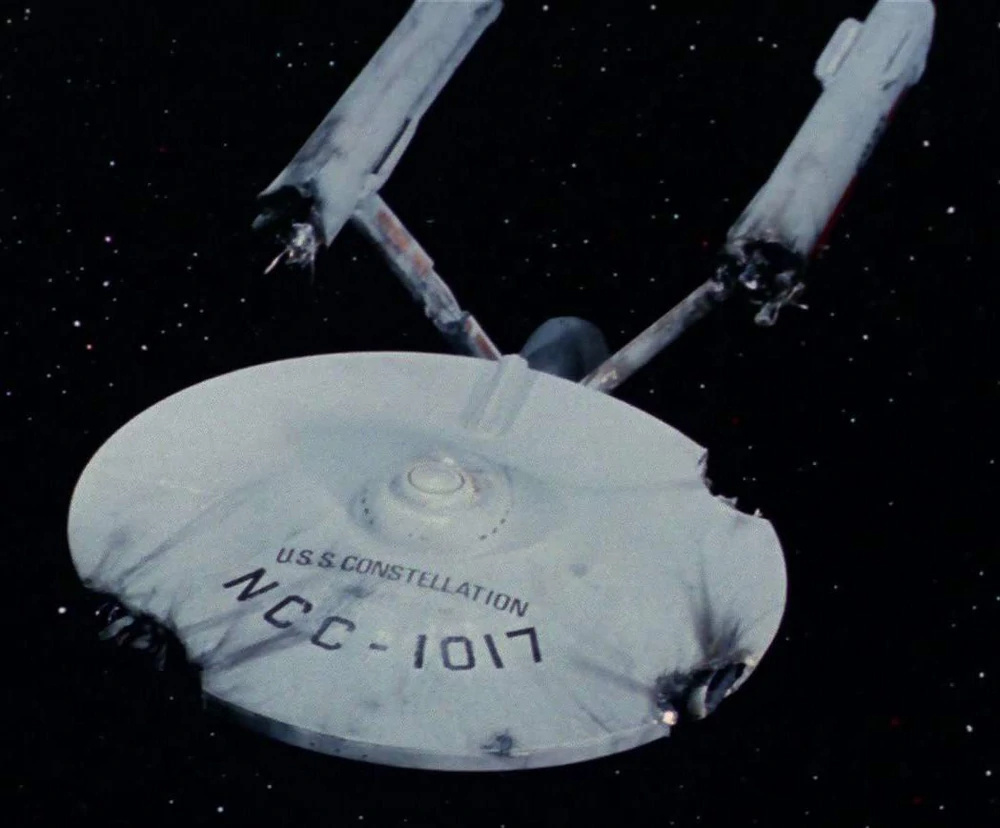
The AMT models of the day weren't highly accurate, but they were based on Matt Jefferies' drawings, not the filming model. It looks a lot like Franz's drawings. In fact, I wouldn't be surprised if franz used the kits as a reference.

The original post is below:
I'm creating a thread for this to separate it from the other Star Trek projects I do, because this is a project I feel should stand alone. For those who don't know, I've built a lot of TOS Constitution class ships over the years. I don't know how many, I've done them in Truespace and Lightwave. But, I'm using Blender now and I need a Constitution class. But, I don't want to try to recreate the filming models. Not because it's difficult, at this point I can say with no real ego that I can get pretty close to accurate with little effort. That's mainly due to the amount of references available. There are great blueprint sets and lots of photos. So, doing the ship as it appeared on the show is a good thing, but just kind of mundane. Boring, if you will.
But, back before there were great references, before the internet age, there was basically only a couple references for this ship as far as schematics go. Those were the blueprints and technical manual drawn and written by a man named Franz Joseph.
For those who don't know, Franz Joseph was a German technical artist. In WW2, he devised a way to create pretty accurate schematics of enemy planes based on photos. If the photos had a size reference in them, he could even calculate the size. Franz wasn't a Star Trek fan. But, his daughter Karen was. In the early 1970s, she was a member of a local Star Trek fan club. Eventually, the fan club got big enough that they started having meetings. Franz went with her for the first meeting and saw where people in the club had made reproductions of props from the show that were very crude. He told them they could do better, so they said "show us." At home, Karen grabbed some slides from the show and Franz went to work creating schematics of props from the show, starting with the communicator. A week later, he had a few schematics drawn and they invited some members of the fan club over and they went crazy over the schematics. Then they started giving him requests for stuff to draw. He quickly realized they wanted a technical manual, so he set about making one. Using slides, pictures, the show in syndication and any other references he could get, Franz made schematic drawings from Star Trek, the first work of its kind being done by someone not connected to the show. He sent some work to Gene Roddenberry, and Gene loved it and encouraged him to continue. The Star Fleet Technical manual was published in 1975, as were a complete set of Constitution class blueprints that Franz had drawn.
For the longest time, these were the best references we had. To remind people, the actual ship was in the basement of the Smithsonian and had some inaccurate parts on it. So, he couldn't even look at the actual model. He had to get by with the series, photos and slides. Over the years, people have criticized his work as being inaccurate, but I dare any of them to do better with what he had available. I'm sure they couldn't. The more accurate sets of blueprints were done by people with access to the 11' model who could take measurements from it.
Franz's work was even used in the films. In TMP, during the establishing shot of Epsilon IX, you can hear the USS Columbia being ordered to rendevous with the USS Revere. They're both identified a "scout" ships. Both "scout" and those two ship names are straight out of the tech manual. Also, the Dreadnought Entente was calling the station. Both "dreadnought" and the ship name were from the manual. For TWOK, they actually did a series of animated displays for the bridge of the ships and they used pages from the tech manual, so the scout, transport and an outline of the dreadnought all appear on screen and are technically canon. And finally, in TSFS, when Checkov says there's an energy reading from inside Spock's quarters, there are blueprints of the inside of the ship displayed, they're from Franz's blueprint sheets. More recently, a ship obviously based on the scout/destroyer design from the tech manual appeared in Strange New Worlds.
So, I decided to build the Constitution class, but based on Franz Joseph's work. I have both his technical manual and blueprints and I love them, even if they are inaccurate. I started this a few days ago and this is where I am:




And, some screenshots:





This has been a fun one so far. The secondary hull on the filming models was done on a lathe. However, this version seems to be more based on Matt Jefferies' drawings. The sides and bottom are more bulgy than the top, especially the bottom. So, needless to say, there was some Sub D involved.
As for the rest of the thread, after I do the Connie, I plan to do the other ships from the technical manual, as well as the Starfleet Command space station. I'm only going to use the blueprints available that are based on Franz's work, and the technical manual as my references. I'm not using any other blueprints, photos or screenshots. If anyone says anything is inaccurate based on the filming model, I'm simply going to refer them back to the post. Also, accuracy is in the eye of the beholder. I can say that a ship that looks more like Franz's work appeared at least once in TOS, and that was the USS Constellation, which was built using an AMT model kit:

The AMT models of the day weren't highly accurate, but they were based on Matt Jefferies' drawings, not the filming model. It looks a lot like Franz's drawings. In fact, I wouldn't be surprised if franz used the kits as a reference.
Post edited by evil_genius_180 on
Additional credits
- Icons from Font-Awesome
- Additional icons by Mickael Bonfill
- Banner background from Toptal Subtle Patterns
© Scifi-Meshes.com 2001-2024


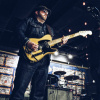


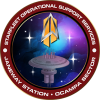
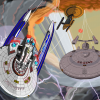
Posts
I'm looking forward to this!
I still have my copy of the Manual, it was one of the first sci fi books I ever bought as a kid......ugh, I just gave away my age.
Yeah, that's the logic I'm using. In the real world, there are variants of ship classes that look slightly different, and there's precedent for that in Star Trek as well. This definitely isn't going to represent the USS Enterprise, I'll pick a name out of the tech manual that I feel suits the ship.
No worries about giving away ages. I bought my copy at a used bookstore almost 30 years ago, when I was teenager.
Just realized I've had my copy for about 30-35 years now. O.o Got it and Scotty's Guide at the same time. Time does fly.
I added the thingamabobs on the sides and bottom of the engineering hull. Unlike on the series models, they don't cut into the hull, they curve from the hull to their resting place parallel to the deflector housing. This is consistent with the blueprints.
Though, the blueprints also have this:
I don't know what the heck that weird bump out section that doesn't follow the contours of the hull is supposed to be, but I didn't replicate it. Everything else follows the blueprints. Another place I'm going to stray from the blueprints is with the grid on the hull. On the blueprints, the saucer and neck have grid lines but the engineering hull doesn't. I'm going to put a grid on the engineering hull.
After seeing the direction Star Trek design has been going the past few years, I'm appreciating the early designs more and more.
I have a feeling there are a lot of us in this boat....
EDIT: The inboard profile doesn't help either.
Various Work: U.S.S. Constellation - Matt Jefferies Concept Shuttle
This is a fantastic project idea- Karen is a friend of good friends of my wife, and when I was recently talking about my copy of the Manual they chimed in with a couple of thoughts. The funniest bit of having the first printing is how it sort of just disappears on a shelf... poor thing.
I love the idea of FranzTrek coming to life even digitally. (though like was mentioned, it's on screen, baby!)
That's actually really cool that you know people who know her. I only know of her from an interview with her father. Quite a bit of stuff from his tech manual and blueprints were used on screen. It's a shame that Roddenberry later decided that he didn't like the work. He went as far as to put in the TNG writers' bible that there were no 1 or 3 nacelle ships, which invalidated some of FJ's designs. Though, TNG broke that rule anyway with the Wolf 359 graveyard scene.
And, we have some of the same books.
I like your rank pins and movie badge too. (and phasers) I have the TWOK style pin on badge and some of the Quantum Mechanix badges that are magnetic. I have them stuck to my refrigerator.
Well, that's nice to know. About the bump anyway. Aside from the bump, I straight followed the side profile for the top and bottom and the bottom profile for the sides. So, mistake or not, those shapes are there.
Various Work: U.S.S. Constellation - Matt Jefferies Concept Shuttle
That's assumed by most to be Matt Jeffereies' 1967 drawings of the ship that were provided to AMT for building scale model kits. So, if the shapes are wrong, we can blame Jefferies. Or, more accurately, we can blame the people who built the studio models for not following Jefferies' drawings as closely as the should have. But then, as I said previously, the studio model bodies were turned on lathes, and you don't get shapes like that side profile on a lathe.
The inboard cutout on the nacelle is interesting. It's much more square than on the studio models. I tried to replicate it as best I could, but the blueprints are a bit iffy there, so I threw in some artistic license.
https://www.cygnus-x1.net/links/lcars/blueprints/sftm/03-11-20.jpg
as well as the inboard on sheet 5.
Various Work: U.S.S. Constellation - Matt Jefferies Concept Shuttle
And yes, I'm familiar with that nacelle blowup. It's in the technical manual, which is right next to me.
I've been studying the 11' model for years, so guess how it looks to me.
And, to be fair, it's not even right on the money with those blueprints. As is typical with drawn blueprints, things don't exactly match from one view to the other. Like Tallguy said, there are some mistakes in these. If you draw a straight line above something like the intercoolers on the nacelles in the front view drawing, you can really see how they don't even line up on one view. But, that's the nature of drawing things, it's very hard to make something match when you're doing it by hand. So, I have to decide which view I'm going with. Mostly, I'm lining stuff up with the side view. I'm very forgiving when it comes to hand drawn blueprints, but less so with stuff done in vector graphics programs, where you can literally clone stuff to get the same curves and line things up to a straight line with accurate rotation, etc.
I don't mind the newer designs, but I don't like it when they come at the expense of the older work. Take the Enterprise from Discovery/SNW for example. I like the design, but I don't like that they retconned it into being the TOS Enterprise. They're essentially saying that now, in canon, Matt Jefferies', Richard Datin and the people at Production Models Shop's original work no longer exists. I have an issue with that. I have less issue with the JJ Abrams designs just because they were clear that it's an alternate reality. That means that there's still the original classic out there, just in a different reality.
I was talking to one of my coworkers at work yesterday while we were working on a project. Like me, he loves Star Trek. He was talking about the HD TOS project from what seems like ages ago now. I told him I think it's cool for what it is, and I own and have seen every episode, but also that I'll probably never watch them with the CGI effects again. They original episodes are great and they had to put a lot of ingenuity into those old effects, like when they used corn flakes for asteroids. A lot of people did a lot of work to make those effects the best they could possibly be within the budget. But, luckily, they were less short sighted with the Blu-Ray release of TOS, and they included the original effects for those of us who still love them.
Yes, but it happens sometimes with fan made blueprints. Even officially published ones.
Thanks Eric. I plan to keep going.
Let's see, according to the technical manual, the one on the inboard "trench" is the Control Reactor Loop (Primary Power Stage.) The ones towards the rear of the nacelle are the Final Stage Intercoolers.
Something I just have never noticed through the years...
Hey, nice!! I've got a feeling that if we could do some sort of transporter pub crawl to each other's places of residence for this forum, we'd encounter a lot of very familiar only slightly different. ;-) I know some folks can do the whole austere me and my pc thing or such, but I am so not one of those. My studio (so, yeah, not the rest of the house) has about 3k books in it right now... sigh... along with kits, sculpts, reference, etc etc etc...
One day I should get out the various blueprints and diagrams and see where some of MJ's work persisted and where FJ's work upped the ante, or someone saw it and said hm yeah, let's have some of that, preferring his interpretations to the real props/models. This thread has definitely got some wheels turning, again it's really a kick-ass idea.
Yep, they're angled, especially on this version. With the regular blueprints based on the 11' model, I make them straight and then angle them. However, the FJ blueprints have the front and back perpendicular to the hull and then the top angled, so I built them that way. I just need to look at the side view to figure out if they're too tall. The might be, but they otherwise line up with the blueprints.
Damn, I haven't seen the Star Trek Encyclopedia in print in ages.
Needless to say, most of this software won't even run on a modern computer, even if I was running Windows. However, I have an old business Dell with Windows XP Pro on it hooked up for when I want to boot up some memories.
I also have a dedication plaque, but it's for the NX-01. I was supposed to get the 1701-E plaque too, but Eaglemoss sent me the wrong one, so I got a second NX-01 plaque. That was shortly before Eaglemoss declared bankruptcy.
I hope you do that one next…perhaps with the AMT..